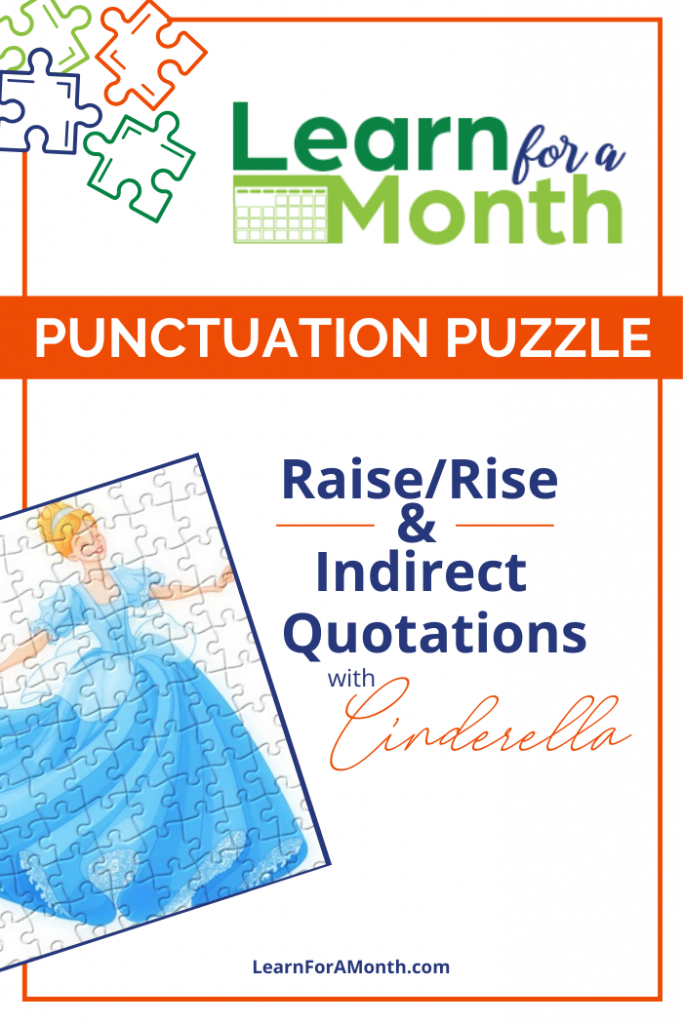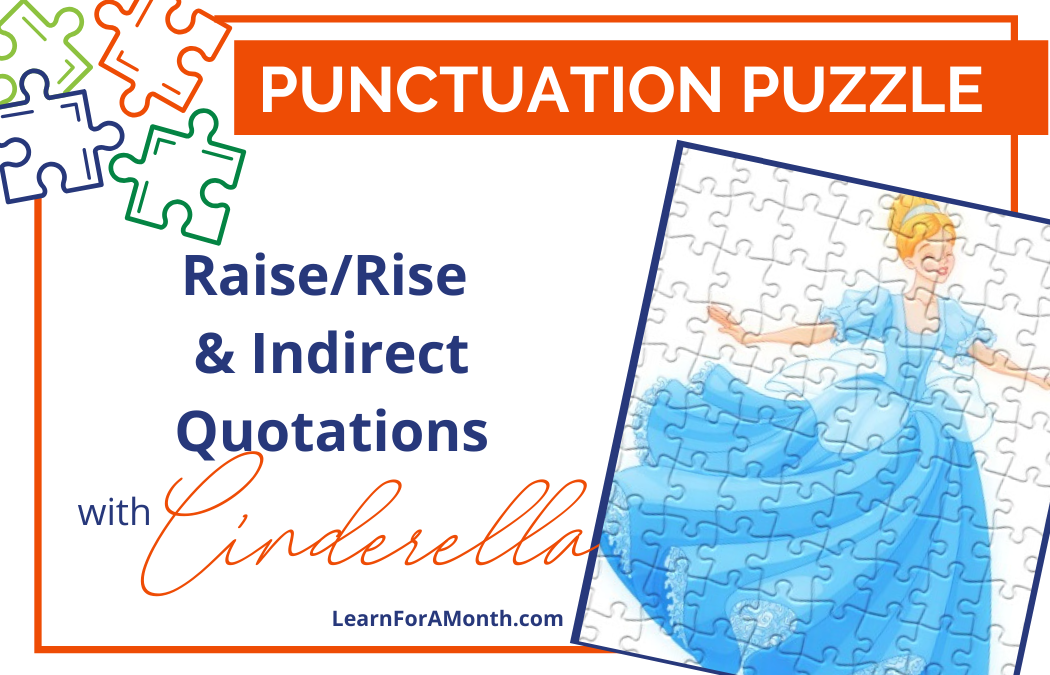Zac and Cinderella do a great job explaining the RISE and RAISE problems in today’s puzzle. But RISE and RAISE cannot be taught alone—so Zac has prepared two more Punctuation Puzzles scheduled to follow this one about those similar confusing word pairs—Set/Sit and Lay/Lie.
I will leave you without a couple of teaching tips—and I will drip more teaching tips in the next two weeks of confusing word puzzles. There are some definite ways, phrasing, and order to help with these difficult concepts, and our students deserve the very easiest way to learn complex topics such as these:
1) Start with a rhyme or mnemonic:
SIT and RISE have I—and LIE does too
‘Coz these are things that I, all by myself, can do.
SET, RAISE, and LAY are words that you choose
When each one has an object at the end to use.
2) Do NOT start with Lie. It is by far the most confusing pair. If you get some momentum with some easier ones, lie and lay will not seem so difficult. And don’t teach them unrelated to each other! They are related, and the concepts make more sense when taught consecutively.
3) Start with sit/set if not teaching from a Christian perspective. If you are teaching in a Christian school setting, start with RAISE and RISE. Kids are used to hearing that Jesus rose from the grave or has risen (all by himself). They are used to hearing that God RAISED his Son.
More later….happy puzzling! 🙂

PUZZLE…
Cinderella had to raise early to do her chores, while her step-sisters slept late and had no responsibilities. Her stepmother excused this injustice by saying, “Cinderella needed to be thankful that she had food and a place to sleep.”
The answer?
Cinderella had to rise early to do her chores while her step-sisters slept late and had no responsibilities. Her stepmother excused this injustice by saying Cinderella needed to be thankful that she had food and a place to sleep.
Raise/Rise—
The first problem in our sentences is a result of confusing the words raise and rise.
1. The word RAISE
a. Raise means “to lift up or cause to go up.”
b. “raise” is something that is done to or for something or someone. Therefore, this verb must have an object. For example,
i. Example 1 –
—The fairy godmother raised her wand and transformed Cinderella’s ragged dress into a beautiful gown.
—What did the fairy godmother raise (what is the object of the verb raise)? She raised her wand. The wand did not raise itself; it was raised by the fairy godmother.
ii. Example 2 –
Cinderella’s harsh and unloving stepmother raised her.
iv. Who did Cinderella’s stepmother raise (what is the object of the verb raise)? She raised her (Cinderella). Cinderella did not raise herself; she was raised by her stepmother.
2. Rise means “to ascend, go upward, or increase.”
a. “to rise” is not something that is done to or for something or someone. Therefore, this verb never has an object.For example,
i. Example 1 –
—The first night, Cinderella carefully kept track of the time, and just before midnight, she rose from her seat and left the palace.
—Cinderella is the one doing the rising here. There is no object (from her seat is a prepositional phrase).
ii. Example 2 –
—When she heard her sisters arrived home, Cinderella rose quickly and greeted them eagerly, pretending to be anxious to hear about the ball.
— Again, Cinderella is the one doing the rising here. There is no object (quickly is an adverb, not an object).
3. Now, let’s check out how this works in our problem sentences:
Cinderella had to raise early to do her chores, while her step-sisters slept late and had no responsibilities. Her stepmother excused this injustice by saying, “Cinderella needed to be thankful that she had food and a place to sleep.”
4. To determine whether to use raise or rise, we need to determine whether there is an object or not. Looking at the sentence, there is not an object for raise.
5. Also, Cinderella is the one doing the action; she is not having an action done to her or for her. Even though her stepmother is making her do this, she is not mentioned in the first sentence; therefore, she is not grammatically doing the action to Cinderella.
6. Since we have no object and Cinderella is the one doing the action, we need to use rise in this sentence:
Cinderella had to rise early to do her chores, while her step-sisters slept late and had no responsibilities. Her stepmother excused this injustice by saying, “Cinderella needed to be thankful that she had food and a place to sleep.”
Indirect Thoughts—
The second error in our sentences relates to indirect quotations.
1. Unlike a direct quotation (the person’s actual words, which are put in quotation marks), an indirect quotation is a sentence in which the writer says what the person said, but says it in the writer’s words.
2. Therefore, indirect quotations do not need quotation marks around them.
3. Now, let’s check out two examples:
i. Example 1 –
—The fairy godmother told Cinderella that she had to leave the ball by midnight.
—We can tell that we are using an indirect quotation, not a direct quotation here because the word that comes before the words the fairy godmother says.
ii. Example 2 –
—Cinderella’s stepsisters told her it was ridiculous for her to even desire to come to the ball.
— Even though the word that is not used here, you can still tell that we are using an indirect quotation. This is because Cinderella’s stepsisters’ words would not make sense as the specific words they would say to her.
—-While talking to her, her sisters would not say, “It was ridiculous for her to even desire to come to the ball.” Though they might say this while talking to someone else about Cinderella, while talking to Cinderella herself they would instead say something like “It is ridiculous for you to even desire to come to the ball.”
4. Finally, let’s see how these concepts work in our problem sentences:
Cinderella had to rise early to do her chores, while her step-sisters slept late and had no responsibilities. Her stepmother excused this injustice by saying, “Cinderella needed to be thankful that she had food and a place to sleep.”
5. The stepmother’s words cannot be a direct quote because no one would say the specific words, “Cinderella needed to be thankful that she had food and a place to sleep.” That wouldn’t make any sense.
6. Therefore, we are dealing with an indirect quotation. Because of that, we need to remove the comma after saying as well as the quotation marks:
Cinderella had to rise early to do her chores, while her step-sisters slept late and had no responsibilities. Her stepmother excused this injustice by saying Cinderella needed to be thankful that she had food and a place to sleep.
And that gives us our final sentences:
Cinderella had to rise early to do her chores, while her step-sisters slept late and had no responsibilities. Her stepmother excused this injustice by saying Cinderella needed to be thankful that she had food and a place to sleep.
Today’s Punctuation Puzzle sentence comes from a student writing assignment found in the “Cinderella Twice-Told Tale” project.

